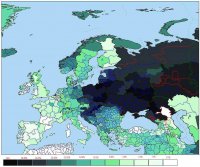Gloria Jean y'Edynak
Current Anthropology, Vol. 17, No. 3. (Sep., 1976), pp. 413-428.
CONCLUSIONS
"Mathematical analyses of Pre-Slavic and Early Medieval populations of the karst and Dinaric zones of Yugoslavia show virtually no difference between them. This implies that the indigenous population of this region was not exterminated or replaced by a new population; rather, the new group seems to have contributed less in terms of genes and more in terms of language and other aspects of culture. The other possibility is that the Slavs exterminated and replaced the indigenous population in the karst and Dinaric zones but possessed almost exactly the same material culture. The former model seems the more appropriate."
Ann. Hum. Genet. (2002), 66, 261-283
Mitochondrial DNA variability in Poles and Russians
B. A. MALYARCHUK, T. GRZYBOWSKI, M. V. DERENKO, J. CZARNY, M. WOZNIAK and D. MISCICKA-SLIWKA
(650 probands)
Despite the high level of mtDNA variation in
Poles and Russians, both populations exhibit a
similar pattern of mtDNA haplogroup distribution,
which is also typical for many European
populations studied. Moreover, the analysis of
distribution of CR haplotypes and subclusters
shared between Poles and Russians has shown
that both Slavonic populations share them
mainly with Germans and Finns. These data
allow us to suggest that Europeans, despite their
linguistic differences, originated in the common
genetic substratum which predates the formation
of the most modern European populations.
Од грчки блог:
4. Interestingly, the Slavs of FYROM have an R-M458 frequency of
3.8%, barely different from that of Greeks at large, suggesting that (i) the claims of some Greek nationalists that they Slavs of FYROM are newcomers to the Balkans
are wrong, just as (ii) the claim of some FYROMian nationalists that they are markedly different from Greeks are wrong.
The actual truth is that the Slavs of FYROM are largely of old Balkan (pre-Slavic) stock who adopted a non-Balkan Slavic language, just as the modern Turks are largely of old Anatolian (pre-Turkish) stock who adopted a non-Anatolian Turkic language.
http://dienekes.blogspot.com/2009/11/finally-structure-in-haplogroup-r1a.html
Haplogroup R1a testing
Haplogroup
R1a is found today across a large swathe of Asia and Europe and may have originated in South or Central Asia.
R1a is most common among
Pakistanis, Northern Indians, Russians, Ukrainians and the
Kyrgyz and
Altai peoples of Central Asia. In Europe
R1a is the
most common group in
Slavic peoples and is also very common in
Scandinavia. The presence of
R1a in the British Isles is in the main due to
Norse Viking ancestry, although Anglo-Saxons and Danes will have carried a smaller proportion there and there is a rare English-specific subgroup. It has been hypothesised that haplogroup
R1a was carried to Europe by the
Kurgan culture, who domesticated the horse.
http://www.ethnoancestry.com/R1a.html
Значи како што погоре си стои,
Ра1 НЕ е “Словенски“ ген ти имбецилу

, туку е најчестиот заеднички ген за популациите кои
денеска ги нарекуваме Словени, врз база на јазичната група.
Genetics
Further information:
Genetic history of Europe
Haplogroup R1a Distribution
Мислам дека ги виде мапите, и дека во Македонија доминира R1a исто како и во Чешка, Полска, Србија, Русија, Украина и др. Па дури и во некои Туркски земји во кое населението се измешало...
:tv:
The modern Slavic peoples come from a wide variety of genetic backgrounds. The frequency of
Haplogroup R1a [17] ranges from 63.39% by the
Sorbs, 56.4% in Poland , 54% in Ukraine, 47% in Russia and 39% in Belarus,
to 15.2% in Republic of Macedonia, 14.7% in Bulgaria and 12.1% in
Herzegovina.
[18] Haplogroup R1a may be connected to the spread of
Proto-Indo-Europeans (see
Kurgan hypothesis for more information).
A new study
[9] studied several Slavic populations with the aim of localizing the Proto-Slavic homeland. The significant findings of this study are that:
- Two genetically distant groups of Slavic populations were revealed: One encompassing all Western-Slavic, Eastern-Slavic, and two Southern-Slavic populations (north-western Croats, Slovenes), and one encompassing all remaining Southern Slavs. According to the authors most Slavic populations have similar Y chromosome pools — R1a, and this similarity can be traced to an origin in the middle Dnieper basin of Ukraine during the Late Glacial Maximum 15 kya.[19]
- However, some southern Slavic populations such as Macedonians and Bulgarians are clearly separated from the tight DNA cluster of the rest of the Slavic populations. According to the authors this phenomenon is explained by "...contribution to the Y chromosomes of peoples who settled in the Balkan region before the Slavic expansion to the genetic heritage of Southern Slavs..."[19]
И една мочана Википедија ти го кажува истото само треба да се потрудиш да прочиташ:
http://en.wikipedia.org/wiki/Slavic_peoples#cite_ref-Bideleux_6-0
Што е со останатите 85% Лупенце?
Ра1 води потекло од Балканот уште ПРЕД населување на т.н. Словени на Балканот или хипотезите за нивните миграции.
--- надополнето ---
Хаха, уште една нова етикета добив.
Значи генот потекнува негде од Украина, или поточно од Карпатите, и оваа Хаплогрупа (R1a) доминира кај сите Словенски народи.
Мислам дека ги виде мапите, и дека во Македонија доминира R1a исто како и во Чешка, Полска, Србија, Русија, Украина и др. Па дури и во некои Туркски земји во кое населението се измешало...
Еве ти и нова мапа да видиш колку сме слични со Украинците, Чесите, Пољаците и Хрватите.
http://www.le.ac.uk/genetics/maj4/EuropeMap+Tree.jpg
:nesvest: :pos2:
Можеш да вршиш извоз на идиотизам:

Adapted from: Separating the post-Glacial coancestry of European and Asian Y chromosomes within haplogroup R1a. Underhill, Kivisild, et al. European Journal of Human Genetics (2009), 1–6.
Ете ти ги “Словените“ во Индија и Сиберија и Кина :pos2:





 , туку е најчестиот заеднички ген за популациите кои денеска ги нарекуваме Словени, врз база на јазичната група.
, туку е најчестиот заеднички ген за популациите кои денеска ги нарекуваме Словени, врз база на јазичната група.